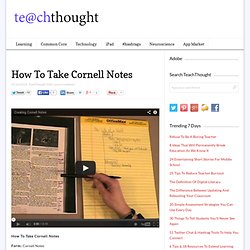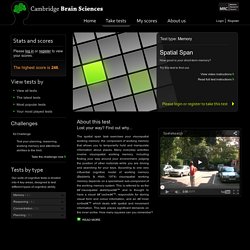Memory & Learning
> Tech to Enhance Learning
How To Take Cornell Notes. How To Take Cornell Notes Form: Cornell Notes Purpose: Distill complex text, arguments, etc. into format useful for study Sweet Spot: Grades 8-12, college Background: According to Wikipedia, the system was developed in the 1950s by Walter Pauk, a Cornell University professor who shared the technique in his book “How to Study in College.”

Note-taking is a lost art. While recent trends–including multi-point touch screens, sketch notes, etc. While there are many ways to take notes, Cornell Notes are among the most useful for pure academic study, but they’re also a bit complicated. The video above does a very nice job of showing how to take a text and transfer it into the Cornell Notes format.
How to Memorize Things Quickly. People like to joke that the only thing you really “learn” in school is how to memorize.

As it turns out, that’s not even the case for most of us. If you go around the room and ask a handful of people how to memorize things quickly, most of them will probably tell you repetition. That is so far from the truth, it’s running for office. If you want to memorize something quickly and thoroughly, repetition won’t cut it; however, recalling something will. The problem is that recalling something requires learning, and we all learn in different ways.
Before we start, you need to establish something: are you an auditory, visual, or experiential learner? Step 1: Preparation To optimize your memorization session, pay close attention to which environment you choose. Next, start drinking some tea. As we get older, toxic chemicals will damage our neurons and synapses, leading to memory loss and even Alzheimer’s. Step 2: Record What You’re Memorizing. MemTrax: Online Memory Test - Fast Memory Screening Test - Memory Exam. Paired Associates Memory Assessment - Cambridge Brain Sciences. In this task you have to remember which objects are hidden in different boxes.

Psychologists call the skills required for this task 'paired-associate-learning', as you are required to learn to pair two items in memory - in this case the type of object and the location of the object. When one of the paired features is revealed (in this case the object), you have to remember its associate (the location it is hidden in). This type of learning is essential in everyday life, for example when learning new words. When you learn a new word, not only do you learn the word itself, but you have to pair this with the meaning it represents. Along with our colleagues at the University of Cambridge and at the Institute of Psychiatry in London, we investigated which areas of the brain become active when performing this task. Furthermore, we studied what happens to this activation pattern when the task gets harder and harder.
References Gould, R.L., Brown, R.G., Owen, A.
Visual Spatial Span Assessment : Cambridge Brain Sciences. The spatial span task exercises your visuospatial working memory; the component of working memory that allows you to temporarily hold and manipulate information about places.

Many everyday activities involve visuospatial working memory, including finding your way around your environment, judging the position of other motorists while you are driving and searching for your keys. According to one very influential cognitive model of working memory (Badderly & Hitch, 1974) visuospatial working memory depends on a specialised sub-component of the working memory system. This is referred to as the ‘visuospatial sketchpad’ and is thought to have a visual ‘cache’, responsible for storing visual form and colour information, and an ‘inner scribe’ which deals with spatial and movement information. This task places significant demands on the inner scribe. How many squares can you remember? References -Bor, D., Duncan, J., Wiseman, R.J.
Verbal Working Memory Assessment - Cambridge Brain Sciences.
The digit span task exercises your verbal working memory.

Scientists refer to working memory as the cognitive system that allows the temporary storage and manipulation of information. According to one influential cognitive theory, this system has specialised components, one of which, the 'phonological loop', underlies verbal working memory abilities (Baddeley & Hitch 1974). The phonological loop is comprised of a verbal storage system and a rehearsal system. If you do this task, you may find yourself mentally rehearsing the string of digits as they appeared on screen; this is the rehearsal system in action. It allows the visual inputs to be recoded so that they can enter your short term verbal store and it also refreshes decaying representations (that is, any item that is about to be forgotten).





